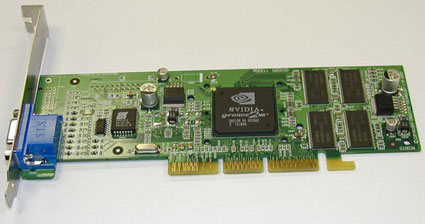De mannen van x-bit labs hebben een review geschreven over de GeForce2 MX kaart van Creative. Deze kaart is niet zoals de meeste MX kaarten uitgerust met 166MHz SDR SDRAM, maar met 143MHz DDR SDRAM. Jammer genoeg is het geheugenbus naar het DDR geheugen slechts 64-bit breed in plaats van de gebruikelijke 128-bit. Met een simpel rekensommetje kunnen we nu uitrekenen dat een normale GeForce2 MX een bandbreedte van 2656MB/sec heeft en de Creative GeForce2 MX slechts een bandbreedte van 2288MB/sec heeft.
Dit valt ook te zien in de benchmarks waar de Creative kaart steevast langzamer is dan een normale MX kaart. Dat Creative van plan was om een erg goedkope GeForce2 MX kaart te maken kunnen we ook aan de kaart zelf zien: op de chip is zelfs geen heatsink te vinden en het stukje PCB is ook niet wat je noemt groot. Voorlopig vallen deze bezuinigingen nog niet te zien in de retail prijs van de kaart, maar de reviewer verwacht dat dit in de toekomst, als de kaart wat langer op de markt is, nog wel zal gebeuren ![]() :
:
Creative engineers planned to develop the cheapest graphics card based on GeForce2 MX chipset, but for a retail buyer it has turned out to be the most freaky card with a moderate price. Among its positive features we can name Creative's traditionally high 2D graphics quality. However, a considerable lag in 3D applications behind regular cards based on GeForce2 MX may be excused only if the market newcomer's currently too high price gets down to reasonable limits. And as the public interest to this new unusual card will cool down, its price is likely to turn even lower than that for similar cards equipped with SDR memory.
But to our mind, Creative developed this graphics card not for the mass retail sales but for large OEMs. These are usually long-term contracts, so constructive and marketing decisions should ensure the maximum reliability and a long-lasting attractiveness of the graphics cards.
This version is corroborated by the low-profile design of the card and the absence of a cooler and heatsink (brand name OEMs tend to equip their PCs with no supplementary active cooling and restrict themselves to only nominal cooling). Furthermore, graphics cards in PCs like that are much more rarely overclocked. Thus, the card may be made as cheap as possible because price is the main determinant for OEM partners.
 |
